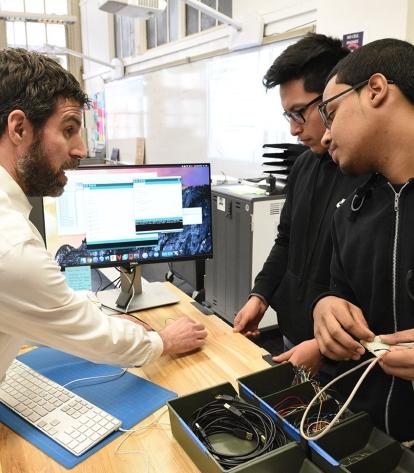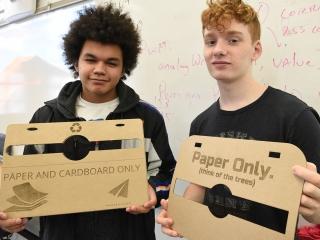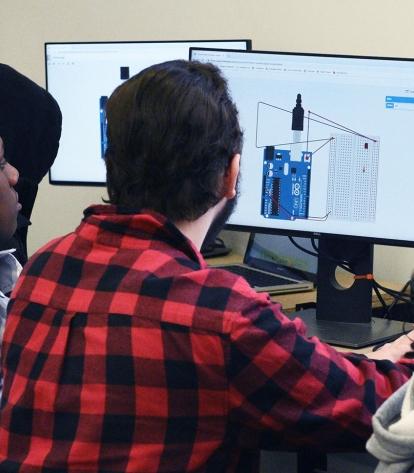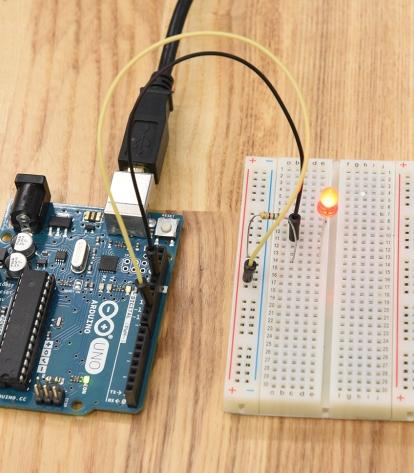“When I started this class, I didn’t know anything about coding. Mr. Rothman makes it enjoyable, and to my surprise I’m really good at it,” Edwin said. “We start basic, and then we run into a challenge. He gives me the motivation to solve that challenge.”
For his accomplishments as a teacher of advanced math, robotics and technology and design, Rothman was recently awarded a 2018 Sloan Award for Excellence in Teaching Science and Mathematics.
“My goal is that students start to see themselves as problem-solvers, and that there’s a process by which we approach problems using the lens of the tools we have in class,” Rothman says.
In Rothman’s robotics and parametric design class for seniors, that process includes a scaffolded structure that Rothman jokingly calls the “eat-your-veggies exercise.” Students first practice coding virtual circuits by following extensive written instructions and diagrams. Once they’re successful, they move on to a series of challenges to apply what they’ve learned.
Then, in a culminating project, they devise a design of their own. Students’ previous ideas have ranged from the practical — a series of covers for the classroom’s electrical outlets — to the playful, like an attachment that converts chopsticks into a spoon for fans of slurping ramen.
“In the phases of user-centered design, we first identify a problem and ask, ‘Who experiences this problem?’” Rothman says. “Then we observe those people and talk with them, come up with a prototype and test it out.”Last year, for example, Rothman’s students used microcontrollers, 3D printers and laser cutters to build models of new lids for the school’s recycling bins. Then they tested out their designs to see which was the most effective at getting people to use the bins the right way.
Because user-centered design is intended to be collaborative, Rothman’s students typically work in pairs using a “driver-navigator protocol.” One student instructs his partner on how to operate the coding program; then they switch roles.
“This is when I feel the best opportunity for learning really happens,” Rothman says as he circulates among the groups of two — sometimes asking a pointed question, sometimes making a suggestion, sometimes just observing thoughtfully while students work. “Talking with students one on one, I get to see what they’re thinking.”
Rothman himself is well versed in the value of revising one’s plans. Raised in Georgia, he studied biology in college in Montana and served as a biologist with the National Marine Fisheries Service off the coast of Alaska. Then he parlayed his background as a guitar player and keyboardist into a stint as a professional musician who toured internationally with a band. In 2011, Rothman decided it was the right time to jump into teaching.
“I was drawn to New York City and thought it would be an awesome school system to work in,” he says. “It’s so big and on the cutting edge of experimentation. I feel really strongly about public schools, that if we can get it right here, we can make it work across the country.”
While teaching math at the HS for Community Leadership in Jamaica, Queens, in 2012, Rothman built a makerspace for students who wanted to go further with engineering and STEM. He was soon tapped to do the same at the Academy for Software Engineering, where students complete a four-year sequence of computer science classes. The academy, near Union Square, is one of the founding schools in the Department of Education’s Computer Science for All initiative, a 10-year plan to bring computer science learning experiences into every city public school.
“Jonathan’s work ethic is extraordinary. He has applied his obsession with detail and organization to bring a design and modeling curriculum to our school,” says Eric Allatta, a fellow math and computer science teacher. “He blends modeling challenges, process documentation, student-led presentations and discussions into an immersive experience for his students.”
Edwin, the student working to reconfigure his circuit, was certainly immersed in the challenge. As class drew to a close, he suddenly knocked his fist against the table.
“I got it!” he said triumphantly.
Rothman hurried over to survey his work. Sure enough, two LEDs were blinking at the same time. Teacher and student grinned at each other: Challenge complete.



